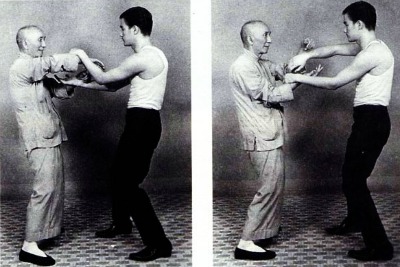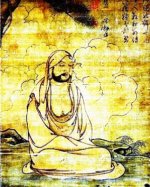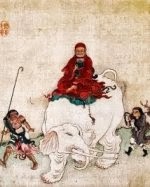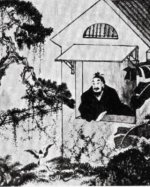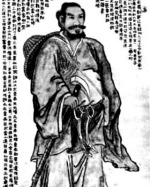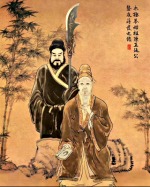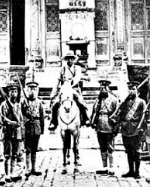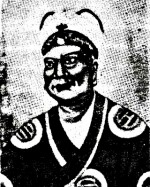A Brief History of Wing Chun Kung Fu
Talk the Talk
Ving Tsun, also known as Wing Chun and Wing Tsun, means forever springtime and is said to be named after its first student,
a 17th-century female expert in Chinese martial arts.
While the validity of this story is impossible to verify, the type of techniques employed are ideal for women and for smaller-built men and at least some of the masters in its lineage can be historically verified.
While the validity of this story is impossible to verify, the type of techniques employed are ideal for women and for smaller-built men and at least some of the masters in its lineage can be historically verified.
Walk the Walk
According to legend the nun Ng Mui, a Bil Gee and Dim Mak master, was inspired to create the new form of kung fu that would develop into
Ving Tsun during her time hiding from government forces at the White Crain Temple.
It is said that the main influence for its conception came when she witnessed a fight between a crane and a snake.
It is said that the main influence for its conception came when she witnessed a fight between a crane and a snake.
Kung Fu Quote
"The world is full of people who are determined to be somebody or to give trouble. They want to get ahead, to stand out.
Such ambition has no use for a gung fu man, who rejects all forms of self-assertiveness and competition".
~ Bruce Lee ~
Such ambition has no use for a gung fu man, who rejects all forms of self-assertiveness and competition".
~ Bruce Lee ~
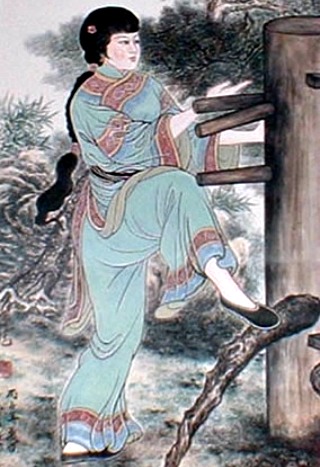 During the reign of the Chinese Emperor K’anghsi (1662 – 1722), a young, athletic woman named Yim Ving Tsun developed a system of kung fu taught to her by a Buddhist Shaolin nun, Ng Mui.
During the reign of the Chinese Emperor K’anghsi (1662 – 1722), a young, athletic woman named Yim Ving Tsun developed a system of kung fu taught to her by a Buddhist Shaolin nun, Ng Mui. After her father, Yim Yee was wrongfully accused of a crime, Yim Ving Tsun moved from her home in Canton to the foot of Tai Leung Mountain at the Yunnan-Szechuan border with her father and her husband-to-be, Leung Bok Chau.
Some scholars believe that in 1644 the Shaolin Temple in the Henan province was attacked by government troops, who saw it as a centre of rebellion against them. The monastery is said to have been burned to the ground killing hundreds of monks and nuns but a few kung fu masters, known as the Five Elders, are believed to have survived.
The Wing Chun style was then passed to Chan Wah Shan, who in turn taught it to the great master Yip Man. It was Grand Master Yip Man who first began to give the style an international reputation as he trained hundreds of students at his Hong Kong headquarters and persuaded many of them to emigrate and open schools all over the world.
This was exemplified by his most famous student, Bruce Lee (pictured with Yip Man below). Lee was the man largely responsible for popularising not only Wing Chun kung fu but all Asian martial arts in the West. Through his movies and books, he gained notoriety on a massive scale and as a result, was able to pass down ancient Eastern knowledge from the martial arts and expose it to a worldwide audience for the first time.
The Origin of Ving Tsun by Grandmaster Ip Man. [Internet]. 1990. Ving Tsun Athletic Association. Available from: http://www.vingtsun.com.hk/Origin.htm [Accessed 07 March, 2014].
Tomlinson, T. [Internet]. 2010. The History of Wing Chun. Lansing Wing Chun – Msu.edu. Available from; https://www.msu.edu/user/tomlins4/Wingchun/More%20about%20Wing%20Chun.html [Accessed 07 March, 2014].
Ving Tsun Kung Fu. [Internet]. 2003. Ving Tsun Kung Fu. Available from: vingtsunkungfu.com [Accessed 07 March, 2014].
Some scholars believe that in 1644 the Shaolin Temple in the Henan province was attacked by government troops, who saw it as a centre of rebellion against them. The monastery is said to have been burned to the ground killing hundreds of monks and nuns but a few kung fu masters, known as the Five Elders, are believed to have survived.
Ng Mui and Yim Ving Tsun
One of those who escaped the slaughter was a nun called Ng Mui who took refuge in the White Crain Temple, from where she got to know Yim Yee and his daughter who lived nearby. Yim Ving Tsun found herself being harassed by a local bully who wanted to force her to marry him.When Ng Mui learned of this, she came to her friend’s aid and started teaching her some fighting techniques. The Abbess took her into the mountains and trained her night and day in kung fu until she was ready to challenge and beat the bully in a fight. Ng Mui then set off to travel around the country leaving strict instructions for her student to practice her kung fu and to use it to help overthrow the Manchu government and restore the recently defeated Ming Dynasty.
The Principles of Wing Chun Kung Fu
Unlike other fighting styles, the Wing Chun system (also known as Ving Tsun) does not use separate block and counter-tactics but rather makes defensive and attacking moves at the same time. As the system was created by a woman, it advocates that size and strength are not important and deflection is employed rather than blocks that use force against force. Some of the most basic principles of the art include:- The shortest and therefore the fastest distance between two points is a straight line.
- The centreline (the plane between the centre of a body and the centre of the opponent's body) is key. Control the centreline and strike along it.
- Do two or three things at once, rather than one at a time.
- Receive what comes, follow what leaves and strike when open.
The Lineage of Wing Chun Kung Fu
After Ng Mui left, Ving Tsun taught the system to her husband, Leung Bok Chau, who was keen to learn the new system after being defeated by her after previously considering her kung fu inferior. He in turn passed it on to Leung Lan Kwai and Wong Wah Bo, who along with his friend Leung Yee Tei, incorporated long pole techniques into the art which became the second weapon used within the system, along with the double broadsword. Leung Yee Tei passed his knowledge down to a famous herbal doctor called Leung Jan, who became a great fighter and successfully fought many challenges against other kung fu masters.The Wing Chun style was then passed to Chan Wah Shan, who in turn taught it to the great master Yip Man. It was Grand Master Yip Man who first began to give the style an international reputation as he trained hundreds of students at his Hong Kong headquarters and persuaded many of them to emigrate and open schools all over the world.
This was exemplified by his most famous student, Bruce Lee (pictured with Yip Man below). Lee was the man largely responsible for popularising not only Wing Chun kung fu but all Asian martial arts in the West. Through his movies and books, he gained notoriety on a massive scale and as a result, was able to pass down ancient Eastern knowledge from the martial arts and expose it to a worldwide audience for the first time.
Written by Andrew Griffiths – Last updated 25/10/2023. If you like
what you see, consider following the History of Fighting on social media.
Further Reading:
Brown, P. C. [Internet]. 2014. The History of Wing Chun. Ohio State University. Available from: http://people.cohums.ohio-state.edu/brown113/webproj/Martial%20Arts%20rob/wing_chun.htm [Accessed 07 March, 2014].The Origin of Ving Tsun by Grandmaster Ip Man. [Internet]. 1990. Ving Tsun Athletic Association. Available from: http://www.vingtsun.com.hk/Origin.htm [Accessed 07 March, 2014].
Tomlinson, T. [Internet]. 2010. The History of Wing Chun. Lansing Wing Chun – Msu.edu. Available from; https://www.msu.edu/user/tomlins4/Wingchun/More%20about%20Wing%20Chun.html [Accessed 07 March, 2014].
Ving Tsun Kung Fu. [Internet]. 2003. Ving Tsun Kung Fu. Available from: vingtsunkungfu.com [Accessed 07 March, 2014].
More Kung Fu History
Kung Fu History Home
Kung fu history arguably goes back to the 6th century CE and the term kung fu can be used to describe any Chinese martial art. Though there are many styles, philosophies and techniques, most trace their ancestry to the Shaolin Monastery in Henan which has been instrumental in the development and spread of many fighting systems down the ages, collectively known in the West as kung fu.
Kung fu history arguably goes back to the 6th century CE and the term kung fu can be used to describe any Chinese martial art. Though there are many styles, philosophies and techniques, most trace their ancestry to the Shaolin Monastery in Henan which has been instrumental in the development and spread of many fighting systems down the ages, collectively known in the West as kung fu.
Bodhidharma
Bodhidharma (Ta Mo in Chinese) was an Indian Buddhist monk who is believed to have travelled to China in the sixth century. So the legend goes, while there he visited the Shaolin Monastery and taught the monks there a set of yogic exercises to improve their overall health. Over time, these exercises would evolve into martial arts, or more specifically, into Shaolin kung fu.
Bodhidharma (Ta Mo in Chinese) was an Indian Buddhist monk who is believed to have travelled to China in the sixth century. So the legend goes, while there he visited the Shaolin Monastery and taught the monks there a set of yogic exercises to improve their overall health. Over time, these exercises would evolve into martial arts, or more specifically, into Shaolin kung fu.
The Early History of Shaolin Kung Fu
A look at how the the history of Shaolin Kung Fu expanded and grew between 527 and 1644. It is believed that many styles of Chinese martial arts have their origins in this period, which also saw the spread of the teachings of the Shaolin monks to temples in other regions.
A look at how the the history of Shaolin Kung Fu expanded and grew between 527 and 1644. It is believed that many styles of Chinese martial arts have their origins in this period, which also saw the spread of the teachings of the Shaolin monks to temples in other regions.
Zhang Sanfeng
Zhang Sanfeng who, according to legend, was the founder of an internal Chinese martial art known as Mien Chuen that would evolve into Tai Chi Chuan. After spending many years training in the Shaolin Temple, he made his way to the Wu Tang Mountains where he developed his new style after watching a fight between a snake and a crane.
Zhang Sanfeng who, according to legend, was the founder of an internal Chinese martial art known as Mien Chuen that would evolve into Tai Chi Chuan. After spending many years training in the Shaolin Temple, he made his way to the Wu Tang Mountains where he developed his new style after watching a fight between a snake and a crane.
The History of Tai Chi Chuan
Tai Chi utilises internal energy, known as Chi, along with physical movements, breathing techniques and meditations. It can be practiced as a martial art or purely for the health benefits it promotes, which include strength, balance, agility, flexibility and stamina along with improved concentration, relaxation and lowered stress levels.
The Shaolin in the Modern Era
The history of the Shaolin in the modern era has not been an easy one. The practice of Chinese martial arts was banned for much of the period and the monks considered enemies of the state because of their political ideologies and later their religious beliefs.
The history of the Shaolin in the modern era has not been an easy one. The practice of Chinese martial arts was banned for much of the period and the monks considered enemies of the state because of their political ideologies and later their religious beliefs.
Pak Mei – A Kung Fu Legend
Pak Mei was one of the famous Five Elders of Shaolin kung fu who developed the fighting system that would take his name. The system is a lethal combination of fighting techniques that combine the explosive power of the tiger with the dynamic speed of the leopard.
Pak Mei was one of the famous Five Elders of Shaolin kung fu who developed the fighting system that would take his name. The system is a lethal combination of fighting techniques that combine the explosive power of the tiger with the dynamic speed of the leopard.
The images on this site are believed to be in the public domain, however, if any mistakes have been made and your copyright or intellectual rights have been breeched, please contact andrew@articlesonhistory.com.

